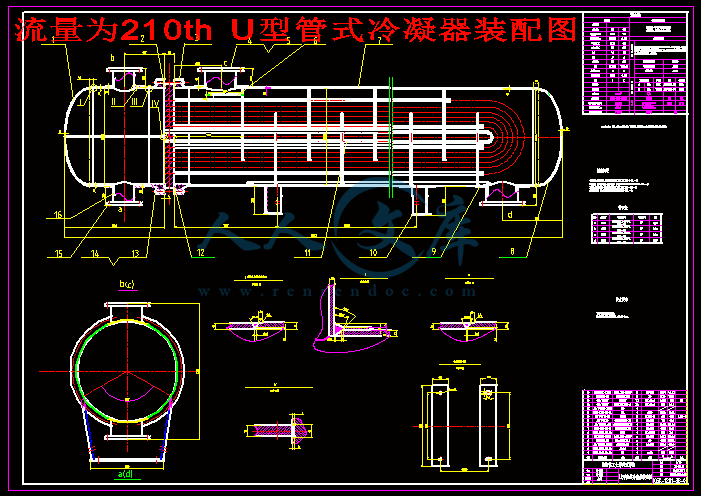流量为210th U型管式冷凝器设计
48页 11000字数+论文说明书+9张CAD图纸【详情如下】





U形管冷凝器管束图.dwg
流量为210th U型管式冷凝器装配图.dwg
流量为210th U型管式冷凝器设计论文.doc
设计图纸9张.dwg
零件图7张.dwg
摘要
换热设备在工业生产中的主要作用是能够使热量从温度比较高的流体传递到温度比较低的流体,从而使流体的温度达到工艺过程中规定的指标,满足工艺过程的需要。换热器中的管壳式换热器是目前应用最为广泛的一种换热设备,已作为一种标准换热设备[1]。这一种换热器的特点是比较容易制造,生产成本相对较低,选用材料的范围比较广,换热表面的清洁相对比较方便,适应能力较强,处理问题的能力较大,在高温和高压的情况下也可以使用[1]。与其他的换热器作比较,它的主要特点是在单位体积内的传热面积较大而且传热效果比较好。除此之外,它的结构简单,操作的弹性也大,所以在高温、高压的情况下以及在大型装备的应用上更多的使用管壳式换热器[1]。
本次设计的题目是“流量为210t/h U形管式冷凝器”,U型管式换热器是管壳式换热器的其中一种,它的结构主要包括管板、壳体、管束等零部件,重量相对比较轻。它将换热管弯成U形,并将换热管的两端固定在了同一块管板上,故而密封面比较少,达到了更加节能的原则。换热器的材料选用恰当,主要结构的尺寸也进行了合理的选择,均能够满足换热器在强度、刚度、稳定性以及水压试验等校核方面的要求。本次U型管式换热器设计的壳程介质为水,管程介质为水。流量为210t/h,壳程的工作温度为95℃,管程的工作温度为20℃,壳程的设计温度为70℃,管程的设计温度为60℃。在其结构上安装有八块折流板,以增加流体的湍流速度。设计压力为管程1.9MPa,壳程0.75MPa。依据给定的条件,查阅GB150-2011《钢制压力容器》,GB151-1999《管壳式换热器》以及换热器手册等标准,通过试算法获得总传热系数,所得传热面积为193.4m2.考虑到介质特性,采用φ25×2×6000的Q345R的无缝钢管,本设计采用412根换热管可以满足换热量。接管法兰我选取了板式平焊法兰,并选用鞍式支座支撑。在本次毕业设计过程中我已经完成了文献综述,设计说明书,一张总装配图和三张零件图的绘制。
换热器在工业、农业等许多的领域运用十分的广泛,当然在日常生活中和现实中的传热设备也随处可以见到,是不可能缺少的工艺设备和单元之一。随着研究的不断深入,工业应用也取得了显著的成效。并且在许多化工单元操作的场合也作为一种十分重要的附属设备进行使用,所以在化工生产中换热器也占有着非常非常重要的地位。
关键词: 换热器; 管壳式; U形管; 管板;
Abstract
Heat exchange equipment in industrial production, the main effect is to be able to make heat from high temperature fluid to the lower temperature of fluid, so that the temperature of the fluid can reach the indexes of the specified in the process, meet the needs of the process. In the heat exchanger tube and shell heat exchanger is the most widely used, a heat exchange equipment has as a standard heat exchange equipment. The characteristics of this kind of heat exchanger is relatively easy to manufacture, the production cost is relatively low, and the use of material range is wide, so the heat exchange surface cleaning is relatively simple, strong ability to adapt, ability to handle problems, in the case of high temperature and high pressure can also use. Compare to other heat exchanger, its main characteristic is in heat transfer area per unit volume is larger and the heat transfer effect is better. In addition, its structure is simple, the operation of the elasticity is big, so in the case of high temperature and high pressure, and the application of in large-scale equipment on the use of more tube and shell heat exchanger.
The topic of this design is the \"flow of 210 t/h\" of u-tube heat exchanger, the U tube heat exchanger is one of the tube and shell heat exchanger, and its structure mainly includes the tube plate, shell and tube bundle components, relatively light in weight. It will be bent into a u-shaped heat exchange tube, and the two end of heat exchange tube fixed on the same piece of tube plate, sealing surface is less so, to the principle of more energy efficient. Heat exchanger of the proper material selection, the size of the main structure is a reasonable choice, all can satisfy the heat exchanger in strength, stiffness, stability, and water pressure test requirements. The shell side of the U tube heat exchanger design medium for water, in the medium for oil passes. The shell side of the flow rate of 210 t/h, the working temperature of 95 ℃, monitor the working temperature is 20 ℃, the design of the shell side temperature is 70 ℃, the design of tube side temperature is60 ℃. In eight pieces of baffle are installed on the structure, to increase the turbulence velocity of the fluid. The shell side of the design pressure for the coil 1.9 MPa, 0.75 MPa. According to the given conditions, consult the GB150-2011 \"steel pressure vessel\" and GB151-1999 \"tube shell heat exchanger and heat exchanger manual such as standard, through the test algorithm to obtain the total heat transfer coefficient, the heat transfer area of 193.4 m squared. Considering the medium characteristic, adopt the phi 25 x 2 x 6000 Q345R of seamless steel tube, the design adopts 412 heat exchange tube can meet the change of heat. Nozzle flange I selected the plate flat welding flange, and selects the saddle support. I have already finished in the process of the graduation design review, design specifications, three part drawing and the drawing of a general assembly drawing.
Heat exchanger used in many fields such as industry, agriculture is very wide, heat transfer equipment in daily life and reality, of course, also can be seen everywhere, it is impossible to a lack of process equipment and one of the unit. With the deepening of the research, industrial application has made significant achievements. Occasions and in many chemical unit operations are also used as a kind of important auxiliary equipment, so the heat exchanger in chemical industry production also plays a very important position.
Keywords: Heat exchanger; Shell and Tube; U-shaped tube; Tube plate.
目 录
第一章、换热器的综述 1
引言 1
1.1 换热器 1
1.2 换热器的发展前景 2
1.3 换热器的工作原理 3
1.4 管壳式换热器类型 3
1.4.1 固定管板式换热器 3
1.4.2 浮头式换热器 4
1.4.3 U形管式换热器 5
1.4.4 填料函式换热器 7
1.5结语 .......................8
参考文献 .................... 9
第二章、设计说明书 10
2.1 原始数据 10
2.2 定性温度及确定其物性参数 10
2.3传热量与水流量计算 11
2.4有效平均温差计算 11
2.5管程换热系数计算 12
2.6结构的初步设计 12
2.7壳程换热系数计算 13
2.8 传热系数计算 14
2.9 管壁温度计算 14
2.10壳程压力降计算 14
2.11 管程压力降计算 15
第三章、U型管换热器结构设计计算 17
3.1换热管材料及规格的选择和根数的确定 17
3.2管子的排列方式 17
3.3筒体内径的确定 17
3.4筒体壁厚的确定 18
3.5 筒体水压试验 18
3.6 壳程标准椭圆形封头厚度的计算 19
3.7 管程标准椭圆形封头厚度的计算 20
3.8容器法兰的选择 21
3.8.1设备法兰的选择 21
3.8.2接管法兰的选择 23
3.9管板的设计 23
3.10管箱短节壁厚的计算 25
3.11 拉杆和定距管的确定 26
3.12折流板的选择 26
3.13防冲板尺寸确定 27
3.14 接管及开孔补强 28
3.15 支座的选择及应力校核 32
3.15.1 支座的选择 32
3.15.2 鞍座的应力校核 33
致谢 37
第一章换热器的综述
引言
根据换热器在现代的工业生产中所起到的作用的不同和其地位的不同,使换热器的种类也变得不尽相同,不一样种类的换热器也各有各的特点,性能也是各不相同。在进行对换热器设计时,第一点应该是根据设计时的工艺要求从而选择适合的换热器种类,接下来是对换热器所需要的传热面积进行计算,进一步确定换热器的结构尺寸。换热器按照其作用和用途不同可分为以下几类:加热器、冷却器、冷凝器、蒸发器、再沸器、深冷器、过热器等。
对于换热器组内的传热,传热过程效果可以分以下为两类:一类是为了对热做功的转换,而第二种类型的目的是使物体加热或者冷却。在相应的过程中,传热的过程同样包含着不同的优化原理,这两种优化原理分别是:熵产最小和火积耗散极大。
通过对换热器进行组内换热过程的分析, 根据不同的原理和在生产需要中的不同需求,从而对换热器组进行了优化,这个优化主要是对其面积的分配。从而确定熵产最小原理,这个原理对换热器设备进行了更进一步的优化,这个原理对于包含在热力循环中的换热器同样适用。火积耗散极大原理,对只含有传热的换热器优化问题更加实用。
在采用熵产最小原理优化过的换热器时,需要考虑冷端换热器产生的熵产、热端换热器产生的熵产和乏汽释放进外界环境所产生的熵产。对换热器进行设计时,设计出来的换热器优化合理、安全可靠是各种各样的外界因素都会影响到的,这关系到设计出的换热器能不能正常的工作和运行、高效率的工作、工作时损耗低、经久耐用。
1.1 换热器
换热器是让冷、热流体进行热量交换的设备,又称热交换器。同时它也是在化工、石油、动力、食品、轻工、能源、制药、机械等领域应用及其广泛的通用设备之一,在工业生产中起到相当重要的作用。在不同的生产条件下可以起到加热器、冷却器、冷凝器、蒸发器等作用,而提高换热器的工作效率和性能更是被认为是提高能源利用的重要因素之一[1]。换热器的作用是将能量高的流体传递给能量较低的流体,从而得到有预期温度和热量的流体。
换热器还有其他的作用,其还能对预热、废热和低品位热能进行回收。伴随着时代的发展,换热器也在飞速的发展,出现了各种种类的换热器,新型结构的换热器、新材料的换热器层出不穷。为了换热器更好的发展,国家对换热器中的一些种类设立了标准,让它们拥有了完整的系列。换热器在各个领域应用是及其广泛的,各种各样的传热设备在我们身边也是随处可见的,已经成了我们生产、生活中不可缺少的设备之一[6]。打个比方,老式的冰箱,空调,都是换热器。
换热器在各个工业部门是应用相当普遍的,像石油、化工、能源动力等。 据有效数据显示,现代的化学工业中总设备的投资里有近30%的资金是投资在了换热器上,而在石油方面对于换热器的投资更是高达总投资的39%,而海水淡化的投资基本上都是投资于换热器,因为这些装置几乎都是由换热器组成的[2]。
在早些年因为没有良好的工艺和较高的科学水平,所以换热器也都比较简陋,那时候的换热器的结构都比较简单,不但传热的面积小而且体积很大,蛇管式换热器就是典型的例子。而随着时代的发展,现代工艺水平提高,出现了管壳式换热器,相比于老式换热器有了长足的进步,各方面性能有明显的提高,大量应用在工业生产中,成为了换热器中的中流砥柱。
致谢
转眼间四年的大学生活就到了尾声,在这四年的学习生活中我收获颇深,为我以后的工作生活打下了坚实的基础,而这一切的收获除了我不懈坚持努力还有这四年各位师长的悉心栽培,虽然我不是你们最出色的学生,我不是你们的骄傲,但是我以有这样优秀的老师们而自豪。又是一年毕业季,思绪万千,曾经大一刚刚踏入校门的懵懂的我们,如今也即将离开校园,你们永远是我最尊敬的老师。此次毕业设计历时三个月,在此,我特别感谢金丹老师,这三个月的时间里,对我进行耐心的指导,对于我的问题细心地解答,倾注了大量的心血,这三个月让我看到了我的老师们严谨的治学态度、渊博的学识、深邃的思想,不仅开阔了我的视野,更是受到了心灵上的启发。让我更加深刻的理解了设计过程中的理念,深层次的理解设计的意义,为以后的要从事的工作打下了坚实的基础。
老师您受累了!!同时还要感谢在设计期间给我关心的同学,各位老师,朋友们,你们是我坚实的后盾,谢谢你们毫不吝惜的帮助。毕业设计是一次讲大学所学统一梳理的过程,如今毕业设计的完成也就意味着我的校园生涯结束,新的生涯即将开始,在以后的生活工作中我也会一直秉承着师长们传递给我的优秀思想,生活态度,一直努力的走下去。
 川公网安备: 51019002004831号
川公网安备: 51019002004831号